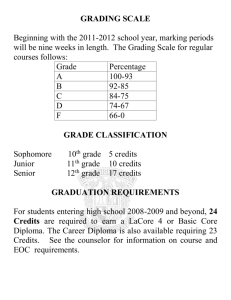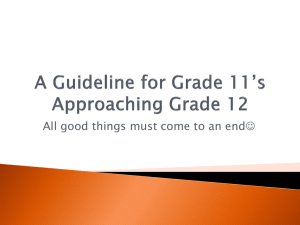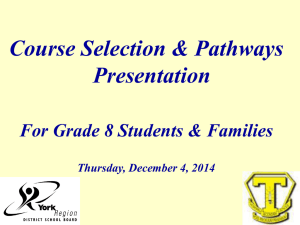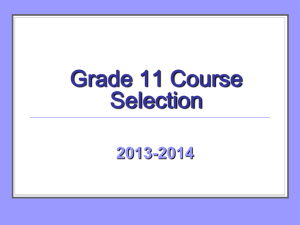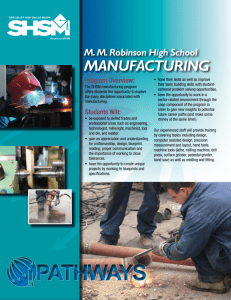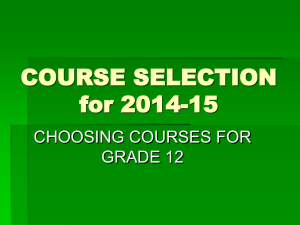Welcome to High School - York Region District School Board
advertisement
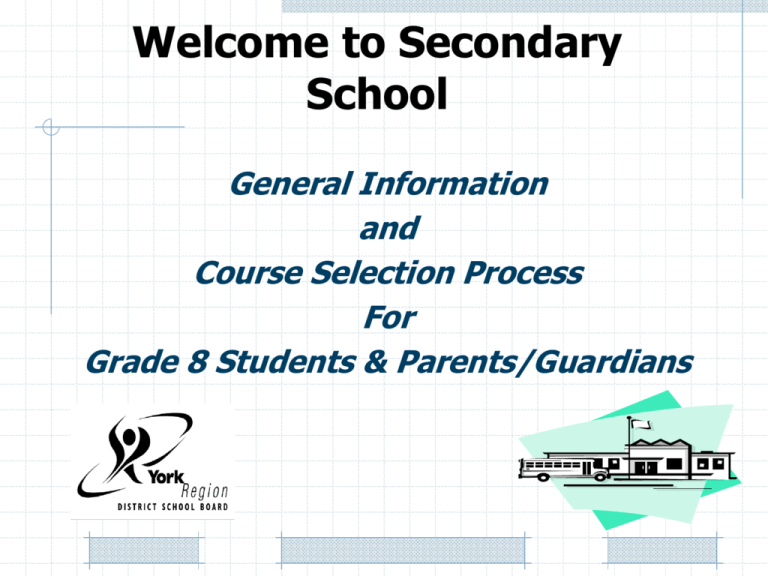
Welcome to Secondary School General Information and Course Selection Process For Grade 8 Students & Parents/Guardians Information ??? The information contained in this presentation is available from the following: • York Region District School Board Regional Course Directory 2008-2009. Available on line at www.yrdsb.edu.on.ca • Our school’s course calendar • York Region District School Board web site – www.yrdsb.edu.on.ca • York Region District School Board Guidance Services Website www.yrdsb.edu.on.ca/guidance.services • Ministry of Education web site www.edu.gov.on.ca for policy and curriculum documents Ontario Secondary School Diploma (OSSD) Requirements 18 Compulsory Credits + 12 Optional Credits = 30 Total Credits (110 hours each) + Successful Completion of the Ontario Secondary School Literacy Test + 40 Hours of Community Involvement 18 Compulsory Credits 4 credits in English (1 credit per grade) 1 credit in French as a second language 3 credits in mathematics (at least 1 in Gr. 11 or 12) 2 credits in science 1 credit in Canadian history 1 credit in Canadian geography 1 credit in the arts (music, visual arts, drama, dance) 1 credit in health and physical education .5 credit in civics & .5 credit in career studies (grade 10) Plus….. Compulsory Credits (continued) Plus: Group 1: 1 additional credit in English, or French as a second language, or a Native language, or a classical or an international language, or social sciences and the humanities, or Canadian and world studies, or Guidance and Career Education (including Learning Strategies), or Cooperative Education* Group 2: 1 additional credit in health and physical education, or business studies, or the arts (music, art, drama), or Cooperative Education* Group 3: 1 additional credit in science (grade 11 or 12) or technological education (grades 9-12), or Cooperative Education* * A maximum of 2 credits in Cooperative Education can count as compulsory credits. 12 Optional Credits Optional credits allow students to build an educational program over the four years that suits their individual interests and meets university, college, apprenticeship or work requirements. The Grade 10 Literacy Test • a test based on language and communication expectations of curricula up to and including grade 9 • if a student does not meet the standard in the first attempt, schools will provide remedial support; the test will be re-administered and/or • the student can successfully complete the Grade 12 Literacy Course Community Involvement • a diploma requirement to complete 40 hours of service • encourages civic responsibility, promotes community values and reinforces importance of volunteerism • a good way to explore career interests The Annual Education Plan (AEP) • Students in high school will continue to prepare an annual education plan • Students will set and track their goals in the areas of academic achievement, career and education exploration, extracurricular and community involvement activities Some Supports in Earning an OSSD • Transfer Courses • Crossover Courses • Substitutions of Compulsory Credits • ESL/ESD Programs • Supports for Special Education and Students at risk Secondary School Certificates The Ontario Secondary School Certificate: • for students who leave school before earning the O.S.S.D. • must earn at least 14 credits The Certificate of Accomplishment: • for students who leave school before earning either the O.S.S.D. or the O.S.S.C. System-Wide Programs in YRDSB • Aboriginal Education (AE) • Active Sport Profile and Intensive Sport • • • • Profile (ASP & ISP) Arts Programs (Arts Huron and ArtsWest) Arts York (AY) Enriched Programs – Advanced Placement (AP), Gifted Programs (GP) Exploring Opportunities Program (EOP) System-Wide Programs in YRDSB (Continued) • French Immersion (FI) • High Performance Athlete (HPA) • International Baccalaureate (IB) • International Cooperative Education (ICE) Program to Ecuador • Personal Support Worker (PSW) Health Care Studies • Specialist High Skills Major (SHSM) Making the Choice…?? • Parents and students will select courses in collaboration with elementary school teachers, guidance counselors and administrators It is important that students do some honest self assessment, matching their ability with their interests and aptitudes Remember that initial decisions made in grade 8 are not “final” decisions. There are many pathways to the destination your child dreams of! Types of Courses – Gr. 9 & 10 In grades 9 & 10, students will choose courses from four types: Applied Academic Open Essential/Locally Developed Gr. 9 & 10 – Definitions of Types • Grade 9 & 10 courses- focus is on establishing solid knowledge and foundation skills • Applied (P) - a real-life hands on approach with some theory • Academic (D) - theoretical in approach, utilizes abstract thinking • Open (O) – an opportunity to explore an area of interest for all students • Essential or Locally Developed (M) – courses intended for students whose educational needs are not met by the provincial courses in English, Mathematics and Science Course Selection (continued) All other selections for Grade 9 will be from the Open type courses. The electives to choose from vary from school to school. The following courses are available at our school for Grade 9: Course Selection In order to meet graduation diploma requirements, it is strongly recommended that students take the following 6 subjects in grade 9. A student may choose all academic courses or all applied or a combination of the two. 1. English - Applied, Academic or Essential 2. 3. 4. 5. 6. Mathematics “ Science “ Geography/History Applied or Academic French “ Health & Physical Education - Open Pathway Planning Important to know: how you learn best diploma requirements to graduate prerequisites for courses how to plan for experiential learning opportunities • admission requirements for postsecondary opportunities • preparing for school-work • • • • Organization of Grade 11 & 12 For grades 11 and 12, students will choose courses based on their intended pathway after high school. There are different destination or pathway type courses as well as the open type courses and transfer courses for students to choose from in these grades. 1. Workplace/ Apprenticeship Courses 2. College 3. University/College 4. University Open + & Transfer Courses Planning for Experiential Learning Experiences Grade 9 Grade 10 Compulsory Credits CO-OP Grade 11 Grade 12 Optional Credits CO-OP Compulsory Credits 18 specific courses are mandated by the Ministry of Education to be elifible for the Ontario Secondary School Diploma (OSSD). CO-OP Education What is a Specialist High Skills Major (SHSM)? A Unique Way to Learn! • Choose a focus for your learning in one of the following areas: • Manufacturing • Construction • Health and Wellness • SHSM is for everyone regardless of whether you are going to an apprenticeship, college, university, or directly to the workplace after high school SHSM’s Move You Ahead • You will receive specialized training and earn industry recognized certifications that will help launch your career after high school • You get experiential learning opportunities in a variety of workplaces and post secondary institutions allowing you to “reach ahead” • You earn a specially recognized diploma accompanied by an SHSM transcript record Employers love it and are looking for graduates with it! Exploring Opportunities Programs (EOP) This program can serve as entry to a Specialist High Skills Major diploma You work on an individualized timetable with one or two teachers in a small group environment You take a package of 4 courses and attend the program at a regional location usually for one semester You return to your home school, the workplace and/or apprenticeship at the completion of the program You get specialized industry training the certificates to prove it along with valuable workplace experience The Pathways linked to Grade 11/12 Programming • Students in Ontario have many options for post secondary training • They can choose from 28 colleges, 19 universities, hundreds of private career colleges and over 140 • apprenticeship opportunities Apprenticeship & Skilled Trades Pathway • YRDSB has the Ontario Youth Apprenticeship Program (OYAP)! Students earn high school credits and competencies towards their apprenticeship • These high demand, highly skilled, highly practical careers are now referred to as “Gold Collar Careers”. Many trades people can earn $75,000 within 3-5 years of high school graduation • Various incentives and resources are available to OYAP students For more information contact your Community Based Education/Co-op Department and visit www.OYAP.com OYAP Requirements 16 years of age, 16 credits enrolled in Co-op full time student competencies in Math, English, Science competencies in the related trade skills a positive attitude and good work ethic Benefits of OYAP offers students a school-work destination with good job prospects allows students to start their post-secondary training program while they earn their high school diploma develops student connections with employers for post-secondary employment as apprentices the destination of choice for experiential learners College Pathway • Community college programs provide a valuable combination of academic and practical/technical skills training for a specific career • There are almost 600 programs to choose from at Ontario’s community colleges including Business Administration, Biomedical Technology, Computer Animation, Engineering Technology, Paramedic, and Social Worker • Seneca College tells us that York University is their biggest feeder school as University Grads discover that they require practical job skills in addition to theory University College • Program links between colleges and universities are increasing dramatically by offering joint programs that will provide students with both the theoretical and practical skills required for their career and earn them a degree and a diploma in four years • Multiple opportunities for transferability between colleges and universities exist • Applied degree programs are now granted by many colleges and universities University Pathway • University programs provide theoretical academic training • In general, there are 4 main types of programs at most universities: Arts/Humanities/Social Sciences Life/Health Sciences Physical/Engineering Sciences Business/Commerce The Workplace Pathway We are all going to work but we enter the workforce at different times in our lives! • There are many viable entry-level job opportunities for students who have completed their OSSD and have workplace experiences • Students who are fast tracking into the workforce/community directly after high school should: work with guidance, community-based education, subject teachers, employment centres to create a personal portfolio (resume, cover letters, letters of reference, successes, etc.) to present to prospective employers and be aware of the value of cooperative education for this preparation Remember…. Pathways are changeable and flexible As interests, skills and aptitudes develop and mature, there will be many opportunities to re-chart our journey Programs for Students At Risk Of Not Meeting Diploma Requirements Program options and strategies may include: • remedial courses/programs (i.e. Learning Strategies) • program which combines Gr. 9 credit courses and remedial skills programs • grouping of students in separate classes and for specialized programs • three essential skills courses in each of English, math and science in Grades 9 and 10 which meet compulsory credit requirements • individual support and guidance Continued... • other essential skills courses to meet optional credit requirements • enhanced opportunities for work experience and cooperative education programs • substitution of up to 3 compulsory credit courses • Certificates • development of an I.E.P. and possible referral to an I.P.R.C Identified Students and Those Receiving Special Education Programs and Services Students who require special education support and services will receive this support according to the needs outlined in their I.E.P. Some may be: • modified curriculum expectations • alternative learning expectations • accommodations to the learning environment; monitoring/in-class resourcing • methods to review student’s progress • student transition plan to postsecondary education, work and/or community living ESL/ELD Support Programs • ESL courses are provided to help students develop proficiency in English • ELD courses are intended to provide students with an accelerated literacy program • these are credit courses which are developed from the curriculum policy document Guidance Services Website • For links to more information on high school programming, the YRDSB course directory, postsecondary options and career exploration visit www.yrdsb.edu.on.ca/guidance.services Check out the excellent section entitled “About High School” The End... Thank you for attending this presentation. Questions can be directed to staff.
